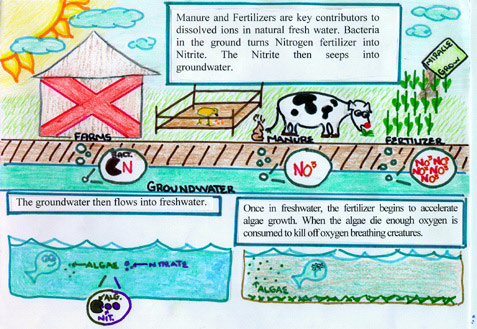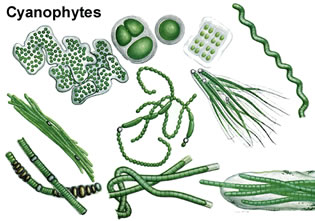| Qualitative and quantitative analysis: |
| A qualitative ( kind or type ) analysis, chemical or biological,
reveals only the presence or absence of that which is being tested
for. Isolating the source by this method is impossible
because the nutrients going into the Carleton water system come from every
organism in the watershed area. If an animal defecates in the
area it will eventually find it's way into the water. Birds, insects,
people their pets, live stock, plants and soil, all contribute. Using
this method of analysis can lead to expensive and pointless pursuits.
Example: Insects die and fall into the river their nutrients contribute
to the influx of minerals. We could hire thousands of people to collect
these insect bodies before they have time to decompose. We could
store these bodies deep in the Canadian shield along with the spent
nucular fuel. This will no help much with the problem. You might say:
No one would be so stupid as to do something like that . Well don't
be so sure. It may sound logical to inspect every septic tank, and
then all small farms ( including some mink farms) but it is as illogical,
as the insect body example, unless your goal is to stall or deflect blame.
No scientist worth his weight in "phosphorus" would recommend qualitative
analysis as a method for finding the source of problem.
A quantitative (amount) analysis, chemical or biological reveals
the amount of that which is being analysed. Isolating
the source becomes relatively easy because it is linked to the location
of the highest concentration. Combining the qualitative and
quantitative analysis will tell you the kind and amount of pollution.
This is true for chemical or biological investigations. Once you know the
kind and amount the outcome is predictable. Ergo the water sample
for testing your well.
Part of the fear among Yarmouth residents is the lack of transparency in the decision making process and this leads to distrust. The fact that the situation has gotten so far out of hand (Ex; Nowlans Lake) without any obvious effort by government or farmers to correct a serious situation and the fact that the new farm on Sloans Lake has links to the possibly the worst biologically polluted lake in Canada...WELL?. How can "you-all" be trusted? "I look to find reason to believe" We need the jobs, but at what cost? |
| River Dynamics |
| When taking water samples it is important to take into consideration
how objects in a water system are moved about. If you lost a canoe
or a paddle you would expect to find it in an area of the system where
the flow of the river was the least. The same happens with algae
it tends to build up at the bottom of deep lakes, coves and
sheltered areas. The nutrients also tend to settle in these areas.
Over time these areas will accumulated algae growth to the point where
eutrification begins. Dissolved oxygen levels are especially sensitive
to the location and depth of sample taken.
Eutrification: The process in which oxygen is removed from the water by the decomposition of large amounts of organic matter. "Adequate dissolved oxygen is necessary for good water quality. Oxygen is a necessary element to all forms of life. Natural stream purification processes require adequate oxygen levels in order to provide for aerobic life forms. As dissolved oxygen levels in water drop below 5.0 mg/l, aquatic life is put under stress. The lower the concentration, the greater the stress. Oxygen levels that remain below 1-2 mg/l for a few hours can result in large fish kills. "(S) Texting Kits. Water testing is easy and relatively inexpensive Example: Master Liquid Test Kit PH - Ammonia - Nitrite - Phosphate Price: $37.43 Other kits are available |

Eutrification |
| For more indepth information check ot the following links. |
|
Quick and easy answers (Blue-Green Algae (Cyanobacteria)) 
2. http://www.d.umn.edu/~seawww/quick/wq.html |